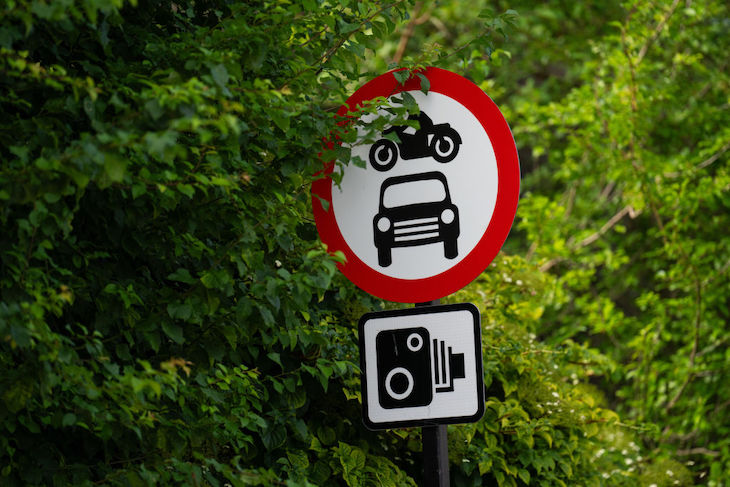At 3am last Thursday morning, council contractors and police descended on a Bristol neighbourhood to install roadblocks under the cover of darkness. Fadumo Farah was one of the residents who got up that night to see what was going on. She was shocked to see dozens of police officers and security guards with drones. It ‘felt like a movie scene,’ Farah said. In a last-ditch attempt to prevent the work proceeding, she – and a group of other residents – lay down in the road.
The operation was the latest episode in a long-running battle over Bristol’s first Low Traffic Neighbourhood (LTN) – known in the local lingo as ‘East Bristol Liveable Neighbourhood’ – in the areas of St George, Redfield and Barton Hill.
Almost two years ago, following a packed public meeting in which people voiced their concerns about longer journey times and the effect on local businesses, the council suspended its plans for the LTN. Subsequently, it ran a second consultation on the scheme which yielded 760 objections and 427 responses in support.
But last November, the council – which switched from Labour to Green following the local elections – started on the work, installing planters and signage in the first of several stages. Almost immediately, with only a few roads closed, the surrounding area became congested. Over the next few weeks, the East Bristol Open Roads campaign group on Facebook filled with pictures of gridlocked traffic, delayed buses and frustrated drivers mounting pavements. One person said they’d been late to work so many times that they were going to resign before they were sacked. Another decided to sell up and leave the area. Thousands signed a petition calling for an immediate halt to the LTN.
‘This whole scheme is just making me feel so sad for everyone negatively affected,’ wrote one resident. ‘People having to leave their jobs, people feeling isolated and stuck in their homes, people (are) stressed every day simply trying to get to work and drop children to school.’
In January, when council contractors came to install the rest of the roadblocks, locals came out to impede them. The ‘protestors’ were 30 campaigners, including one in a wheelchair. They briefly prevailed and the council paused the scheme again.
Before going further, I should declare an interest. Bristol is in the heart of the region where I grew up, and, in 2023, I planned to move there. Staying in an Airbnb for the first stage of my property search, I became alarmed by news of then Bristol mayor Marvin Rees’ plans to install LTNs across the city. While the East Bristol Liveable Neighbourhood was presented locally as a traffic calming measure, I was aware it was part of the national trend for LTNs that followed from the establishment of Active Travel England by central government in 2020. I knew the roadblocks wouldn’t end in east Bristol.
I helped to launch the campaign Keep Bristol Moving, a small group who attended council meetings and organised gatherings of concerned locals. Public awareness of the issue was low, and council communications played to Bristol’s green ethos, promising quieter streets and easier cycling. Hearing councillors and officials talk, I also noticed how the reason for the scheme changed: sometimes it was to do with tackling ‘congestion’ and ‘pollution’; at other times, it was presented as a fix for ‘climate change’ and achieving ‘net zero’.
In time, I abandoned my moving plans, put off by the prospect of what would happen when getting around is difficult. Bristol is a sprawling, hilly city made up of different neighbourhoods and has poor public transport. Its Clean Air Scheme, notorious for mistakes and extortionate fines, has become a commonly-cited reason why people living in the surrounding areas avoid the city. On Facebook, one Bristol-born man expressed an unBritish level of rage about the road restrictions, concluding: ‘If I could place a curse on Bristol Council I would.’
My own periodic visits to Bristol confirm that the centre is getting quieter. Businesses are closing in my favourite area of Park Street, a situation the council is likely to exacerbate with more ‘bus gates’. But the authorities’ use of force and stealth goes beyond road restrictions. The episode epitomises the growing rift between adversarial councils and local communities. It raises questions about the extent and limits of the councils’ powers. Since Covid, in a shift which is going largely undiscussed, local authorities have been doing their best to grab more power. Stepping beyond their traditional role as service providers, many councils appear to see themselves as the managers of public space – and of public behaviour.
Councils can all-but shut down an area, as I discovered last summer when cones and barricades prevented anyone parking within several miles of Avebury, in Wiltshire. In some parts of Kent, enforcement officers have the power to fine people for swearing in the street. The days of the boring-but-benevolent town hall have gone.
Given all this, that dark night in Bristol raises questions citizens are increasingly going to have to grapple with. What do you do when the usual democratic channels fail and councils disregard objections, petitions and emails? If lives can be upended at the stroke of a pen, do we need more checks and balances to protect basic rights?
Regardless of what mechanisms are in place, political legitimacy depends on relationship and consent. Bristol’s case is illustrative. To a recent post by news website Bristol World asking what people would change about the city, many replied with a succinct ‘the council’, some suggesting that Bristol’s elected leaders should be removed. How long can a council retain its legitimacy when it is so widely disliked?
The people of Bristol are in for some interesting times. The south of the city, where the council is planning its next ‘liveable neighbourhood’, has a middle-class population that is less inclined to lie down in the road. If residents don’t want their lives curtailed, they’ve got work to do.






Comments